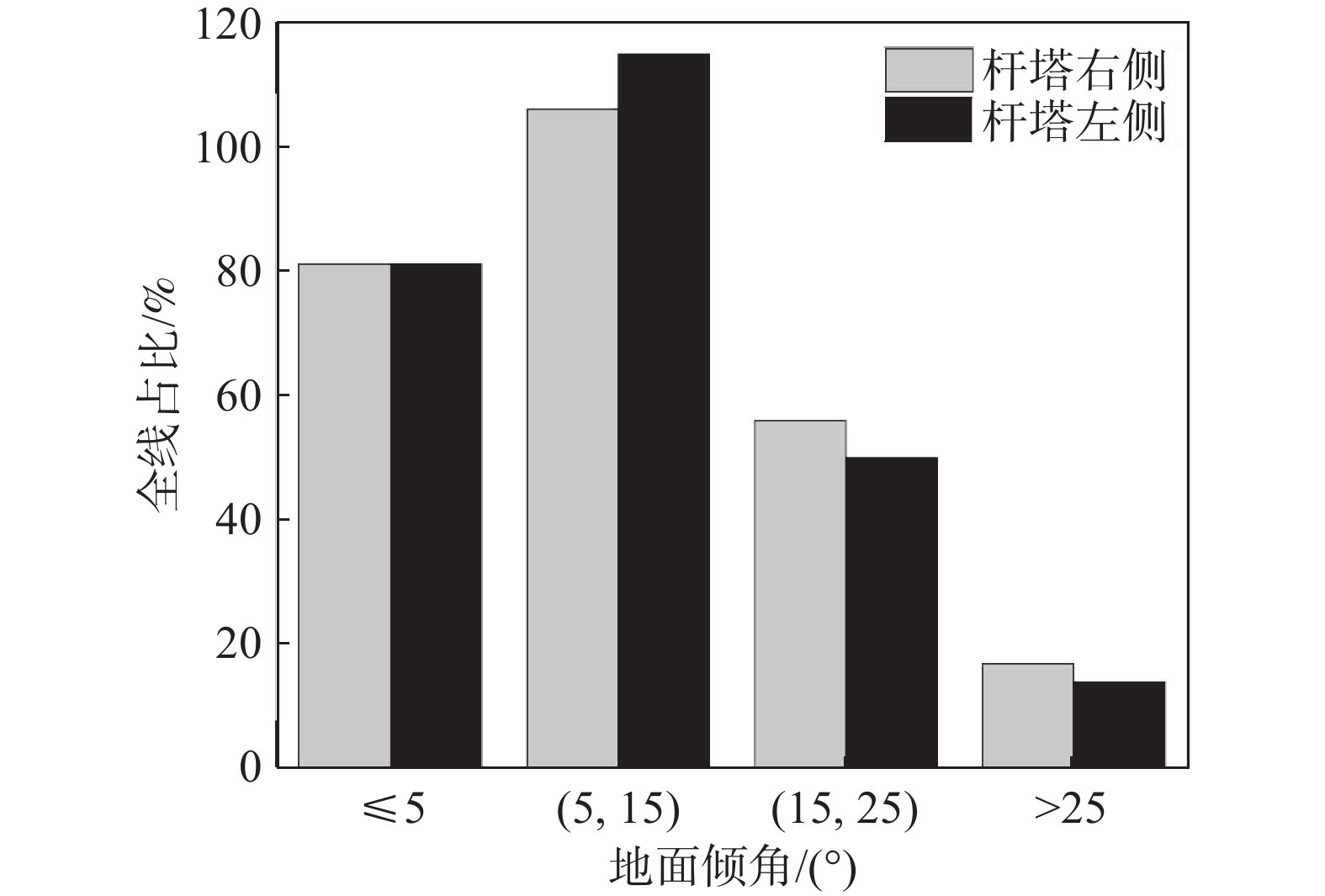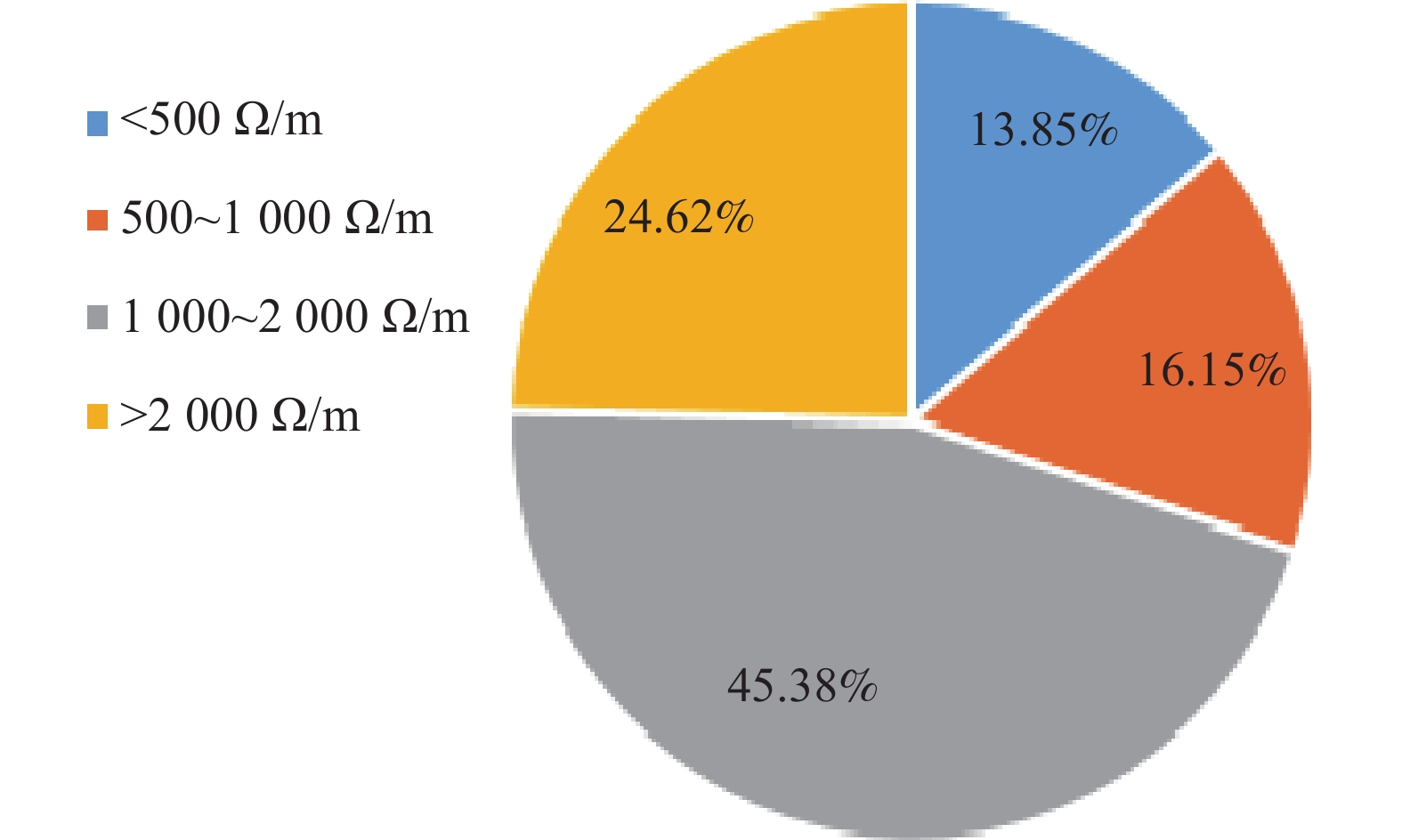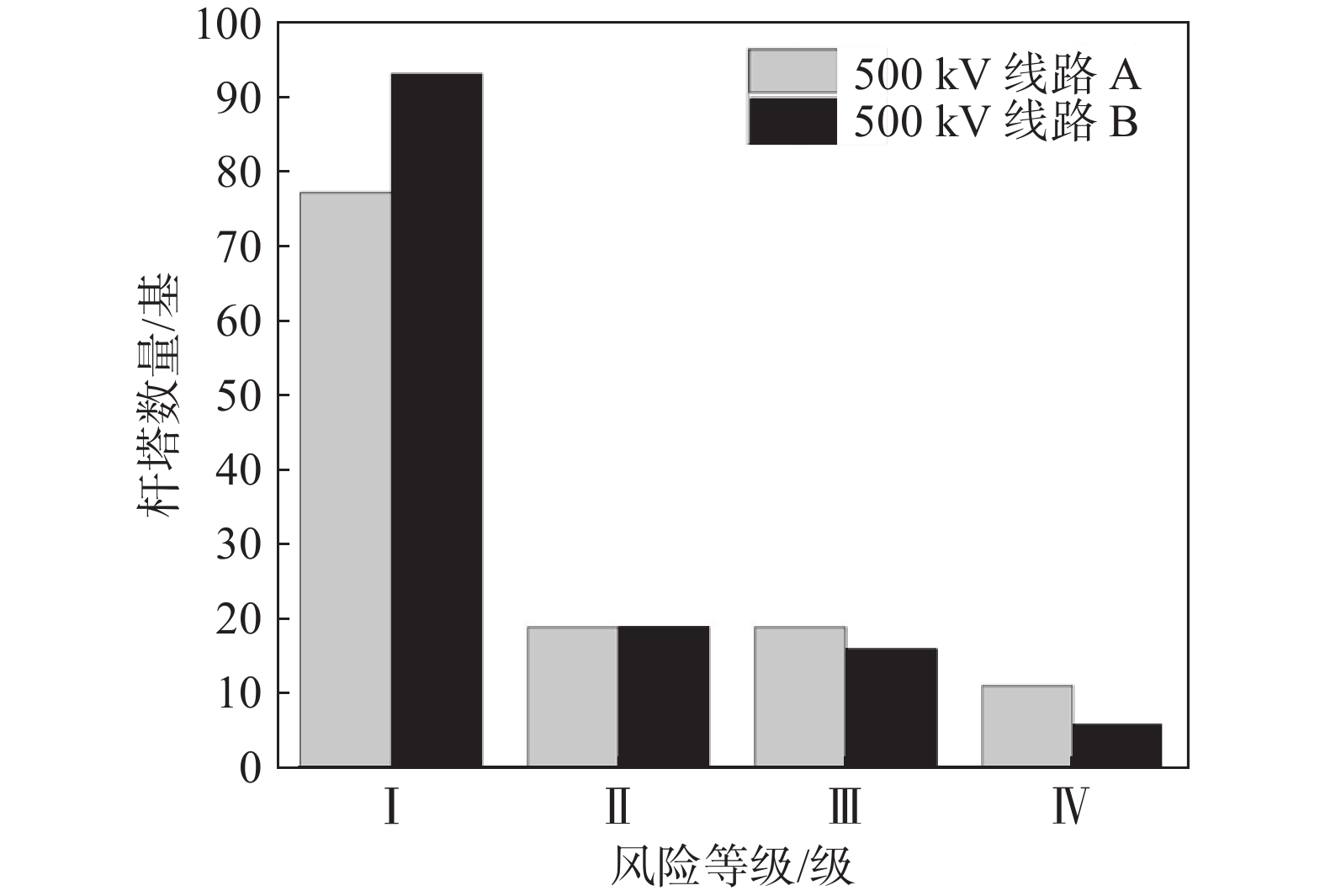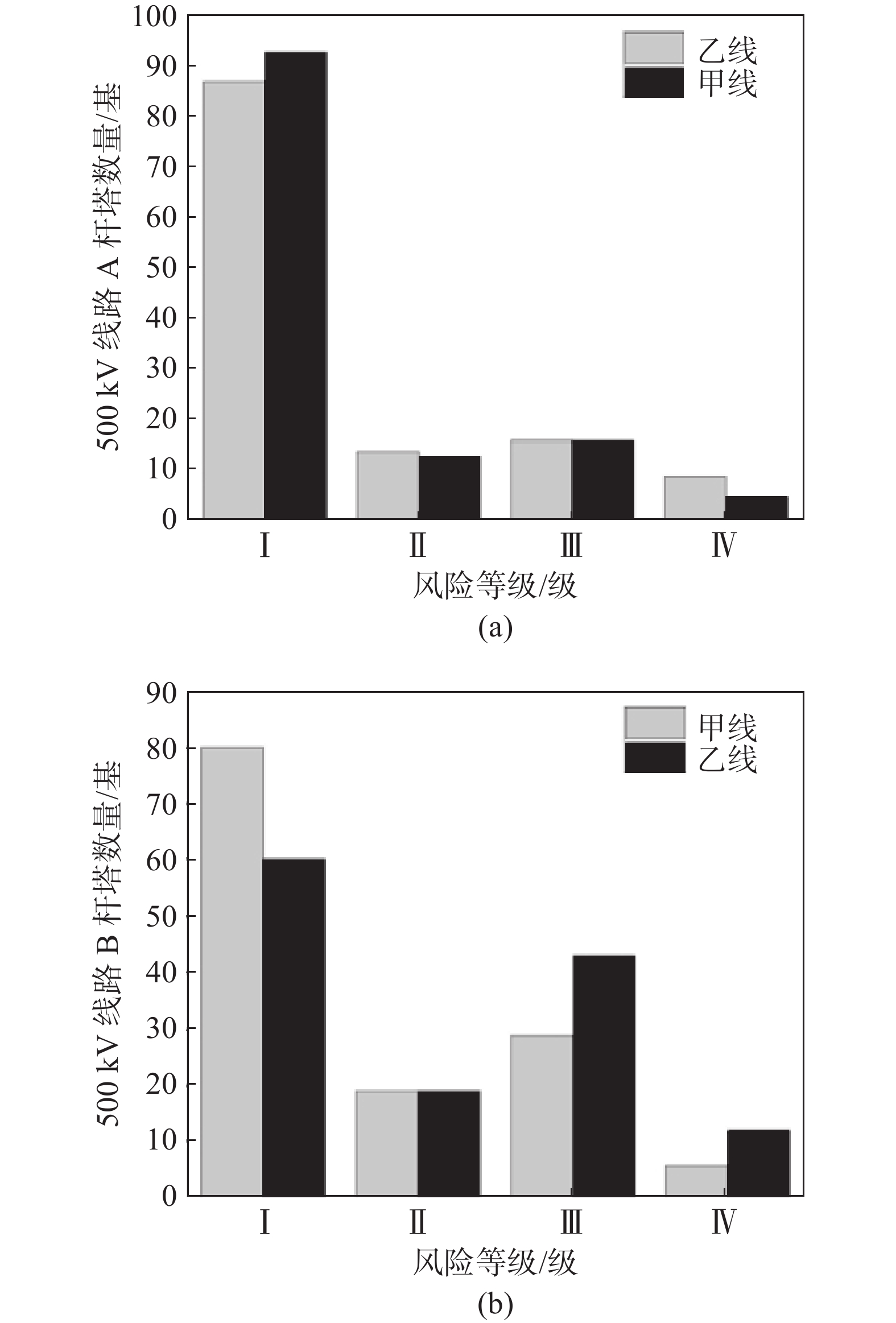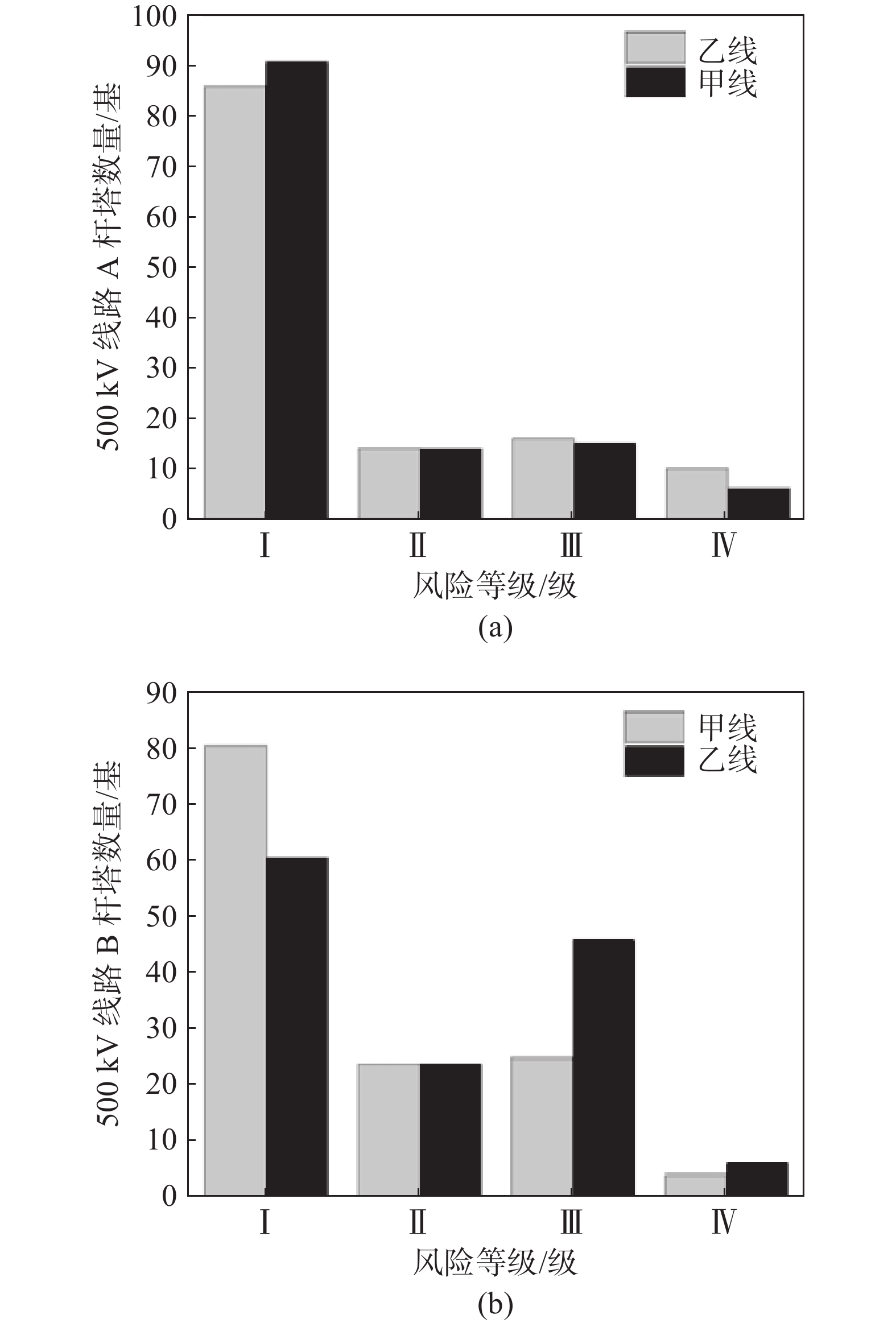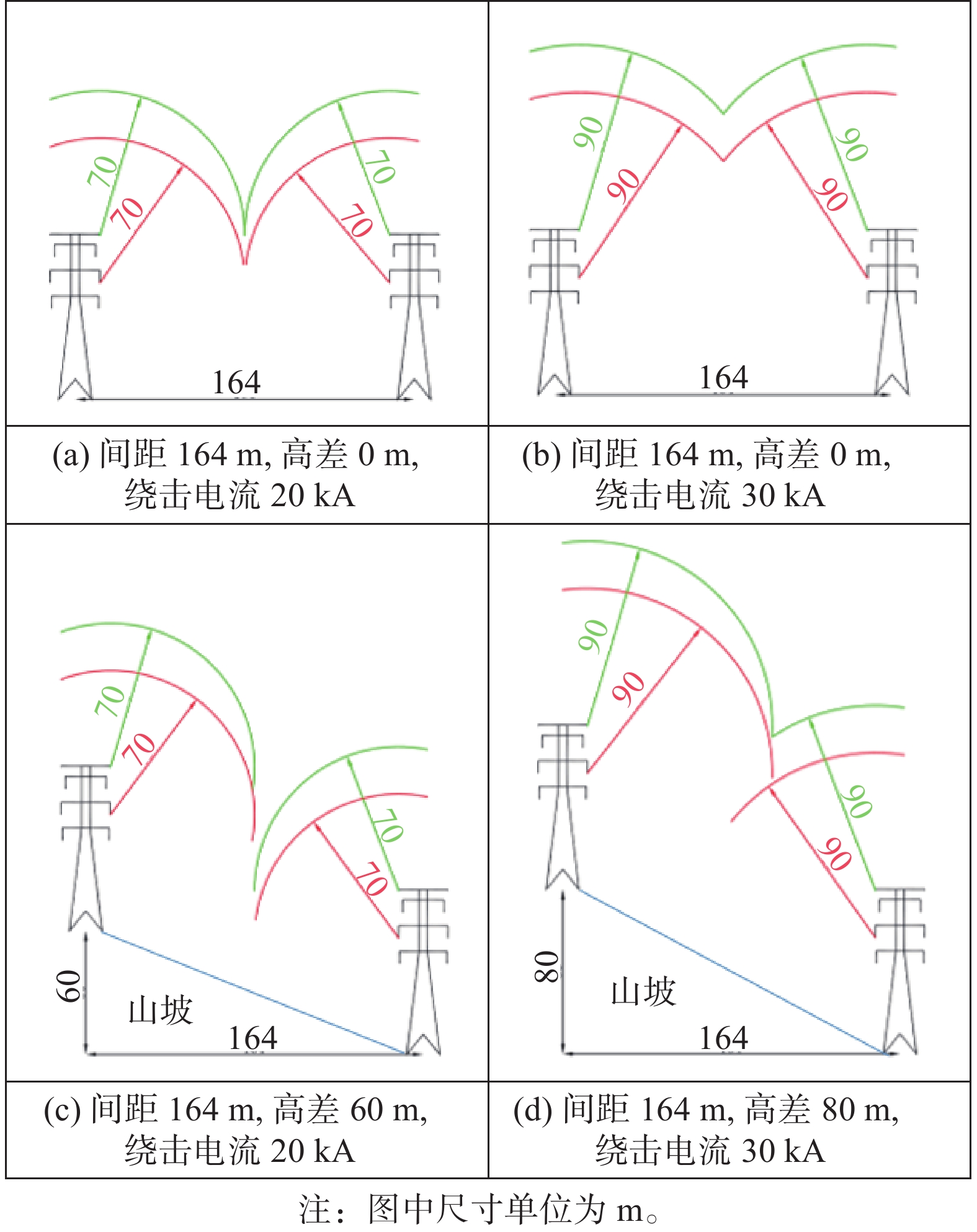-
随着电网的快速发展,500 kV输电线路在远距离、大容量输电中起着非常重要的作用,作为系统核心的网架结构,其安全与稳定性尤为关键。运行经验表明,在我国35 kV~500 kV输电设备事故中,雷击造成的输电设备跳闸事故次数在输电设备跳闸事故中排第1位,造成的输电设备非计划停运事故排第2位。输电线路可靠的雷击防护一直是运行中的薄弱环节,对线路进行准确合理的耐雷性能分析及雷击风险评估是开展线路防雷改造,制定针对性防护措施,降低线路雷击跳闸率,保障线路安全可靠运行的重要手段[1-3]。
目前在开展输电线路雷击风险评估时,一般以雷击跳闸率为计算目标。基于近年来线路区域雷电定位系统监测数据及线路走廊区域的地形地貌情况,结合线路特征结构参数、绝缘配置等信息采用合理的反击和绕击方法来计算各基杆塔及全线的雷击跳闸率,根据雷击跳闸率大小,按照线路雷击风险划分原则确定线路杆塔的雷击风险等级,然后研究制定降低杆塔雷击跳闸率的有效措施,包括安装线路避雷器、降低杆塔接地电阻等[4-6]。输电线路雷击风险评估的关键是准确计算出线路的雷击跳闸率,并合理确定雷击风险等级为防雷改造提供依据,分析时,线路杆塔结构参数、绝缘配置、沿线地形地貌参数、模型准确性及计算方法合理性等都对雷击跳闸率结果有一定的影响[7]。国内外对于输电线路的反击耐雷性能分析方法主要涵盖规程法、行波法、蒙特卡洛法以及电磁暂态计算程序法[8]。其中电磁暂态计算程序法是目前国际上通用的电力系统电磁暂态计算方法,其计算精度已得到各国学者、工程界的认可,目前广泛应用于输电线路耐雷性能分析计算中,因此,文章采用电磁暂态计算程序法计算线路的雷电反击性能。对于雷电绕击的分析方法,目前主要包括规程法、经典与改进的电气几何模型法、先导发展模型法[9]。其中改进的电气几何模型法在经典几何模型基础上考虑了构筑物结构高度对引雷效果的影响,应用简便,且和实际运行经验相比较为相符,该方法在日本、欧美等国家得到了广泛运用,在我国也得到了普遍认可[10],因此,文章采用改进的电气几何模型法计算线路的雷电绕击性能。
500 kV交流输电线路工程沿线走廊雷电活动、海拔、气象、地形与地质条件等因素分布复杂,在工程建设前期开展防雷专项评估、提出必要的保护优化措施是确保工程安全稳定运行的关键,文章依托我国某在建500 kV交流输电线路工程,开展线路耐雷性能、雷击防护措施等方面的分析研究,为今后500 kV交流输电线路的防雷设计及运行提供技术参考。
-
根据雷电定位系统1999~2012年共13 a数据,线路所在地市的平均地闪密度为8.43次/(km2·a)。按照《架空输电线路防雷技术导则》(Q/CSG 1107002-2018)[11]中规定的雷区等级划分原则,该线路位于D1级强雷区(7.98<Ng≤11.0),线路雷击风险较大。
-
500 kV交流线路采用JL/LB1A-400/35型铝包钢芯铝绞线;地线采用OPGW-120-72-2-4型光缆,导、地线计算参数如表1所示。
类型 型号 直流电阻/(Ω·km−1) 外径/mm 500 kV线路 JL/LB1A-400/35 0.071 7 26.8 地线 OPGW-120-72-2-4 0.362 0 15.2 Table 1. Conductor and ground wire calculation parameters
-
以应用于该线路的5D2W2-Z1典型杆塔为例,其导地线布置情况、塔头尺寸等计算参数如图1(a)所示。
杆塔采用多波阻抗模型,对横担及塔身的不同尺寸部位进一步细化为多段波阻抗[12],如图1(b)所示。该模型不仅反应了波在杆塔上的行进,还考虑到了杆塔自身结构及不同高度对地电容的变化。
-
线路绝缘配置方面,悬垂串选用复合及玻璃绝缘子,耐张串采用玻璃绝缘子,统一按照d级污区配置绝缘。全线绝缘配置如表2所示。
串型 单联片数/片 绝缘高度/mm 双联160 kN耐张串 31 31* 155=4 805 双联240 kN耐张串 36 36*170=6 120 双联180 kN复合绝缘子串 1 4 750 双联240 kN复合绝缘子串 1 4 750 双联300 kN复合绝缘子串 1 4 800 双联160 kN玻璃绝缘子串 30+1 31*155=4 805 双联210 kN玻璃绝缘子串 29+1 30*170=5 100 双联300 kN玻璃绝缘子串 25+1 26*195=5 070 Table 2. Line insulation configuration
-
工程沿线地形分布比例以及塔位左、右侧地面倾角占比分别如表3、图2所示。
地形类别 平地 山地 比例/% 10 90 Table 3. Distribution ratio of terrain along the line
沿线土壤电阻率分布如图3所示,接地电阻根据各塔位土壤电阻率实测结果中取值。
-
目前,开展输电线路雷击风险评估的方法有很多,实际上不论采用何种评估方法,最终主要的考察指标还是输电线路(杆塔)雷击跳闸率,并基于雷击跳闸率的大小合理划分确定线路雷击风险等级,本文按照《架空输电线路防雷技术导则》(Q/CSG 1107002-2018)中规定的方法进行雷击风险等级划分,其划分原则如表4所示。
雷击风险等级 Ⅰ Ⅱ Ⅲ Ⅳ 雷击风险程度 较低 一般 较高 严重 杆塔雷击跳闸率 Ri<1.0×S 1.0×S≤Ri<1.5×S 1.5×S≤Ri<3.0×S R≥3.0×S 线路雷击跳闸率 R<1.0×S 1.0×S≤R<1.5×S 1.5×S≤R<3.0×S R≥3.0×S 注:Ri—线路第i基杆塔及其水平档距范围内的雷击跳闸率(折算至年40雷暴日和每百公里长度下的指标)[次·(100 km·a)−1];R—线路平均雷击跳闸率(折算至年40雷暴日和每百公里长度下的指标)[次·(100 km·a)−1];S—各电压等级架空输电线路雷击跳闸率折算至年40雷暴日(即地闪密度2.78次·(km2·a)−1)下的基准参考值,如表5所示。 Table 4. Transmission line lightning risk classification standard
电压等级/kV 110 220 500 ±500 ±800 基准参考值S/[次·(100 km·a)−1] 0.525 0.315 0.140 0.150 0.100 Table 5. Benchmark reference value of lightning trip-out rate for transmission lines of various voltage levels
因此,对于该工程,杆塔(线路)总雷击跳闸率R<0.14时,杆塔(线路)雷击跳闸风险较低;0.14≤R<0.21时,杆塔(线路)雷击跳闸风险一般;0.21≤R<0.42时,杆塔(线路)雷击跳闸风险较高;R≥0.42时,杆塔(线路)雷击跳闸风险严重。
大量运行经验表明,对于500 kV电压等级的线路,由于采取平衡高绝缘的配置方式,杆塔反击耐雷水平较高,线路雷击跳闸绝大多数由绕击导致,绕击跳闸风险较高。因此,本文在划分杆塔的绕击、反击风险时按照85∶15的比例分配,即对于绕击来说,R<0.119时,杆塔(线路)绕击跳闸风险较低;0.119≤R<0.178 5时,杆塔(线路)绕击跳闸风险一般;0.178 5≤R<0.357时,杆塔(线路)绕击跳闸风险较高;R≥0.357时,杆塔(线路)绕击跳闸风险严重。而对于反击来说,R<0.021时,杆塔(线路)反击跳闸风险较低;0.021≤R<0.031 5时,杆塔(线路)反击跳闸风险一般;0.031 5≤R<0.063时,杆塔(线路)反击跳闸风险较高;R≥0.063时,杆塔(线路)反击跳闸风险严重。
考虑到雷击具有一定的随机分散性,在进行雷击风险评估时计算出来的理论雷击跳闸率可能与实际的落雷存在一定差异,因此在采取防护措施时,优先对雷击跳闸率达到IV级的杆塔进行防护,再根据反击及绕击情况针对性地采取措施。
-
采用ATP-EMTP (Alternative Transients Program- Electro Magnetic Transient Program)电磁暂态仿真程序法建立线路260基杆塔反击计算仿真模型,计算了线路逐基杆塔反击跳闸率,结合线路雷击风险等级划分原则,各风险等级的杆塔数量如图4所示。此时500 kV线路A、500 kV线路B全线平均反击跳闸率分别为0.025次/(100 km·a·回)、0.020次/(100 km·a·回),全线平均反击跳闸率在II级及以下。
-
采用ATP-EMTP电磁暂态仿真程序结合改进的电气几何模型法计算线路绕击跳闸率[13-14],结合雷击风险等级划分原则,各风险等级的杆塔数量如图5所示。
计算得到500 kV线路A、500 kV线路B全线平均绕击跳闸率如表6所示,全线平均绕击跳闸率在II级及以下。
线路 绕击跳闸率/[次·(100 km·40雷电日)−1] 左回 右回 500 kV线路A 0.103 0.087 500 kV线路B 0.111 0.164 Table 6. Calculation results of the average shielding failure trip-out rate for the whole line
-
根据杆塔绕击跳闸率与反击跳闸率可得杆塔综合雷击跳闸率,结合线路雷击风险等级划分原则,各线路风险等级的杆塔数量如图6所示。
各线路雷击风险等级达到IV级的杆塔雷击跳闸率详细计算结果如表7所示。可见,线路共有24基杆塔的雷击跳闸率风险等级为IV级,因此需要采取一定的雷击防护措施。
塔号 左侧总 右侧总 乙线风险等级 甲线风险等级 500 kV线路A ZE7 0.007 2 0.466 3 Ⅰ Ⅳ ZE40 0.547 9 0.137 5 Ⅳ Ⅰ ZE47 0.572 5 0.048 3 Ⅳ Ⅰ ZE56 0.098 2 0.447 0 Ⅰ Ⅳ GZE70 0.665 3 0.036 2 Ⅳ Ⅰ ZE77 0.506 0 0.082 8 Ⅳ Ⅰ GZE83 0.551 4 0.229 6 Ⅳ Ⅲ GZE91 0.124 1 0.453 2 Ⅰ Ⅳ ZE95 0.011 5 0.422 1 Ⅰ Ⅳ ZE97 0.473 7 0.239 7 Ⅳ Ⅲ ZE100 0.536 6 0.470 9 Ⅳ Ⅳ ZE107 0.617 8 0.536 1 Ⅳ Ⅳ ZE111 0.464 3 0.019 8 Ⅳ Ⅰ ZE112 0.474 1 0.380 6 Ⅳ Ⅲ 塔号 左侧总 右侧总 甲线风险等级 乙线风险等级 500 kV线路B GZW31 0.174 0.469 Ⅱ Ⅳ ZW36 0.558 0.133 Ⅳ Ⅰ ZW47 0.524 0.374 Ⅳ Ⅲ ZW57 0.276 0.500 Ⅲ Ⅳ ZW60 0.019 0.519 Ⅰ Ⅳ ZW61 0.392 0.523 Ⅲ Ⅳ ZW66+1 0.040 0.488 Ⅰ Ⅳ GZW74 0.487 0.250 Ⅳ Ⅲ GZW76 0.122 0.798 Ⅰ Ⅳ ZW110 0.434 0.099 Ⅳ Ⅰ Table 7. Calculation results of lightning trip-out rate for towers with lightning risk at level IV
-
根据2018~2020年运维数据,在2年4个月的时间里,邻近已投运500 kV线路共计发生了3次雷击跳闸数据,邻近已投运220 kV线路共计发生了9次雷击闪络数据,如表8所示。
线路 雷击位置 雷击类别 地理特征 与本线路位置关系 500 kV线路C #166塔B相
(双回路中相)绕击 平地 - 500 kV线路D #190塔C相
(双回路下相)绕击 山地下坡侧 ≈25 km 500 kV线路D #182塔C相
(双回路下相)绕击 山地下坡侧 ≈25 km 500 kV线路E #16塔A相
单回路边相绕击 山顶下坡侧 ≈43 m 500 kV线路F #88塔C相
单回路边相绕击 丘陵下坡侧 ≈32 km 500 kV线路G #34塔#A相
单回路边相绕击 山地下坡侧 ≈60 km 500 kV线路H #12塔C相
单回路边相绕击 山顶下坡侧 ≈8 km 500 kV线路I #79塔C相
单回路边相绕击 山坡下坡侧 ≈7 km 500 kV线路J #15塔C相
单回路边相绕击 山地下坡侧 ≈56 km 500 kV线路K #183塔A、B、C相双回路 反击 山地 - 500 kV线路L #19塔C相
单回路边相绕击 山坡下坡侧 ≈5 km 500 kV线路G #98塔B相
单回路边相绕击 山地下坡侧 ≈90 km Table 8. Lightning trip data of lines in 2018~2020
结合邻近已投运500 kV线路及220 kV线路的运行经验,应从如下角度降低线路的雷击跳闸风险:
1)重点防范下坡侧中横担及下横担的雷电绕击。
2)220 kV线路E #16塔曾经发生过雷击闪络,其附近的500 kV线路B ZW101塔、500 kV线路A GZE93、GZE94塔,应予以重点关注。
-
由于反击影响整个杆塔,若安装线路避雷器则需要六相导线安装线路避雷器,成本较高。因此,对于反击占比大于10%的杆塔,采取降低接地电阻+安装线路避雷器的措施;其余杆塔根据具体绕击相安装线路避雷器。根据上述原则,挑选得到需降低杆塔工频接地电阻的塔位及其降阻效果如表9所示。
塔号 降阻前 降阻后 接地
电阻/Ω反击跳闸率/
[次·(100 km·40
雷电日)−1]接地
电阻/Ω反击跳闸率/
[次·(100 km·40
雷电日)−1]ZE40 17.61 0.118 0 6.89 0.109 3 ZE77 11.27 0.080 6 3.73 0.070 8 GZE83 19.05 0.072 6 10.27 0.030 6 GZE91 11.35 0.089 1 4.90 0.051 1 ZE97 12.22 0.154 0 5.27 0.112 7 ZE100 13.77 0.133 2 5.39 0.102 0 ZE107 15.40 0.052 4 15.40 0.023 3 GZW31 9.35 0.093 6 4.04 0.068 7 ZW57 17.62 0.131 0 已最高规格 GZW74 16.33 0.053 7 16.33 0.051 0 Table 9. Design changes of tower power frequency ground resistance
根据表9可知,加大接地装置规格后,杆塔反击跳闸率变化不大,对杆塔总体的跳闸率影响较小,因此本文不再采取降低接地电阻的措施。
-
两条同塔双回路平行走线,当平行间距较近时,一条线路的地线对另一条线路的导线也能起到屏蔽作用[15],如图7所示(其中,20 kA为导致绕击的最小雷电流)。
根据图7可知:
1)雷电流越大,地线的对内侧导线的联合屏蔽效果越好。
2)不考虑高差的情况下,两条线路平行间距小于164 m时,两条线路的地线可为内侧导线提供良好屏蔽作用。
3)位于上坡侧的线路的地线可对下坡侧的线路的导线形成较好的屏蔽效果。
4)位于下坡侧的线路的地线可对上坡侧的线路的导线形成屏蔽效果。线路越靠近,屏蔽效果越好;高差越小,屏蔽效果越好。
500 kV线路A、500 kV线路B雷击风险在IV级的杆塔联合屏蔽效果如表10所示。
塔号 平行间距/m 高差/m 联合屏蔽效果 500 kV线路A ZE7 86 10 较好 ZE40 184 30 较好 ZE47 146 20 较好 ZE56 130 10 较好 GZE70 140 10 较好 ZE77 350 20 无 GZE83 146 10 较好 GZE91 434 100 无 ZE95 705 150 无 ZE97 470 70 无 ZE100 720 100 无 ZE107 330 120 无 ZE111 178 40 无 ZE112 210 50 无 500 kV线路B GZW31 78 15 较好 ZW36 80 15 较好 ZW47 152 50 较好 ZW57 148 40 较好 ZW60 150 50 较好 ZW61 130 10 较好 ZW66+1 115 30 较好 GZW74 140 10 较好 GZW76 160 30 较好 ZW110 420 90 无 Table 10. Combined shielding effect of towers with lightning risk at level IV
-
考虑两个线路地线的联合屏蔽作用,按照绕击严重程度挑选杆塔和相别安装线路避雷器。此外,考虑到220 kV线路E #16塔A相曾经发生过雷击跳闸事故,ZW101塔距离其仅43 m,结合地形及雷击跳闸率计算结果择相安装线路避雷器;GZE93塔虽然距离较远(约1 km),但是整体与220 kV线路E #16塔、ZW101处于同一个山顶,因此也结合地形及雷击跳闸率计算结果择相安装线路避雷器。线路避雷器安装情况如表11所示。500 kV线路A共计13基杆塔需安装17支线路避雷器;500 kV线路B共计8基杆塔需安装8支线路避雷器。
塔号 左侧(乙线,东侧) 右侧(甲线,西侧) 上相 中相 下相 上相 中相 下相 500 kV线路A ZE40 避雷器 ZE47 避雷器 GZE70 避雷器 ZE77 避雷器 GZE83 避雷器 GZE91 避雷器 GZE93 避雷器 避雷器 ZE95 避雷器 ZE97 避雷器 ZE100 避雷器 避雷器 ZE107 避雷器 避雷器 ZE111 避雷器 ZE112 避雷器 避雷器 塔号 左侧(甲线,东侧) 右侧(乙线,西侧) 上相 中相 下相 上相 中相 下相 500 kV线路B GZW31 避雷器 ZW47 避雷器 ZW57 避雷器 ZW60 避雷器 ZW66+1 避雷器 GZW76 避雷器 ZW101 避雷器 ZW110 避雷器 Table 11. Installation of line arresters
500 kV线路A、500 kV线路B雷击风险在IV级的杆塔采取防护措施后的风险等级如表12所示。可见,采取措施后,全线无Ⅳ级以上风险杆塔。
塔号 防护前雷击风险等级 防护后雷击风险等级 左侧
(乙线,东侧)右侧
(甲线,西侧)左侧
(乙线,东侧)右侧
(甲线,西侧)500 kV线路A ZE40 Ⅴ Ⅰ Ⅱ Ⅰ ZE47 Ⅴ Ⅰ Ⅰ Ⅰ GZE70 Ⅴ Ⅰ Ⅰ Ⅰ ZE77 Ⅴ Ⅰ Ⅱ Ⅰ GZE83 Ⅴ Ⅲ Ⅱ Ⅲ GZE91 Ⅰ Ⅴ Ⅰ Ⅲ GZE93 Ⅲ Ⅲ Ⅲ Ⅰ ZE95 Ⅰ Ⅴ Ⅰ Ⅰ ZE97 Ⅴ Ⅲ Ⅲ Ⅲ ZE100 Ⅴ Ⅴ Ⅱ Ⅲ ZE107 Ⅴ Ⅴ Ⅰ Ⅲ ZE111 Ⅴ Ⅰ Ⅰ Ⅰ ZE112 Ⅴ Ⅲ Ⅰ Ⅱ 塔号 防护前雷击风险等级 防护后雷击风险等级 左侧
(甲线,东侧)右侧
(乙线,西侧)左侧
(甲线,东侧)右侧
(乙线,西侧)500 kV线路B GZW31 Ⅱ Ⅴ Ⅱ Ⅰ ZW47 Ⅴ Ⅲ Ⅰ Ⅲ ZW57 Ⅲ Ⅴ Ⅲ Ⅰ ZW60 Ⅰ Ⅴ Ⅰ Ⅰ ZW66+1 Ⅰ Ⅴ Ⅰ Ⅰ GZW76 Ⅰ Ⅴ Ⅰ Ⅰ ZW101 Ⅱ Ⅰ Ⅰ Ⅰ ZW110 Ⅴ Ⅰ Ⅰ Ⅰ Table 12. Risk level of lightning on towers with protection measures
采取雷击防护措施前后的跳闸率对比如表13所示。500 kV线路A乙线、甲线和500 kV线路B甲线、乙线的平均雷击跳闸率分别下降31%、21%、22%、23%,且全线平均雷击跳闸率下降至I级。
线路 采取措施前跳闸率/
[次·(100 km·40雷电日)−1]采取措施后跳闸率/
[次·(100 km·40雷电日)−1]500 kV线路A 甲线 0.118 0.093 乙线 0.134 0.092 500 kV线路B 甲线 0.127 0.099 乙线 0.178 0.137 Table 13. Comparison of average lightning trip-out rate
-
1)500 kV线路A、500 kV线路B雷击风险在IV级的杆塔共计24基,占比9.23%,全线平均雷击跳闸率在II级及以下。
2)对于上述杆塔,加大接地装置规格后,反击跳闸率变化不大,对杆塔总体的跳闸率影响较小。因此本文不采取降低接地电阻的措施。
3)本文重点在于防护绕击,考虑技术经济性,结合雷击的随机分散性,优先对雷击风险达到IV级且绕击风险较高的杆塔安装线路避雷器。
4)综合考虑平行走线线路地线的对导线的联合屏蔽效果,以及附近已有线路的运行经验,选取500 kV线路A 13基杆塔安装17支线路避雷器,选取500 kV线路B共计8基杆塔安装8支线路避雷器,合计25支线路避雷器。
5)采取雷击防护措施后,500 kV线路A乙线、甲线和500 kV线路B甲线、乙线的平均雷击跳闸率分别下降31%、21%、22%、23%,且全线平均雷击跳闸率下降至I级,满足《架空输电线路防雷技术导则》(Q/CSG 1107002—2018)要求。
Lightning Performance and Protection Measures of 500 kV AC Overhead Transmission Lines
doi: 10.16516/j.ceec.2024.S1.09
- Received Date: 2023-11-06
- Rev Recd Date: 2023-12-04
- Publish Date: 2024-06-30
-
Key words:
- 500 kV AC transmission line /
- EMTP /
- EGM /
- lightning protection performance /
- lightning trip-out rate /
- lightning protection measure
Abstract:
| Citation: | JIE Tianyu, GONG Youjun, YAN Ziwei. Lightning performance and protection measures of 500 kV AC overhead transmission lines [J]. Southern energy construction, 2024, 11(Suppl. 1): 56-64. DOI: 10.16516/j.ceec.2024.S1.09 doi: 10.16516/j.ceec.2024.S1.09 |




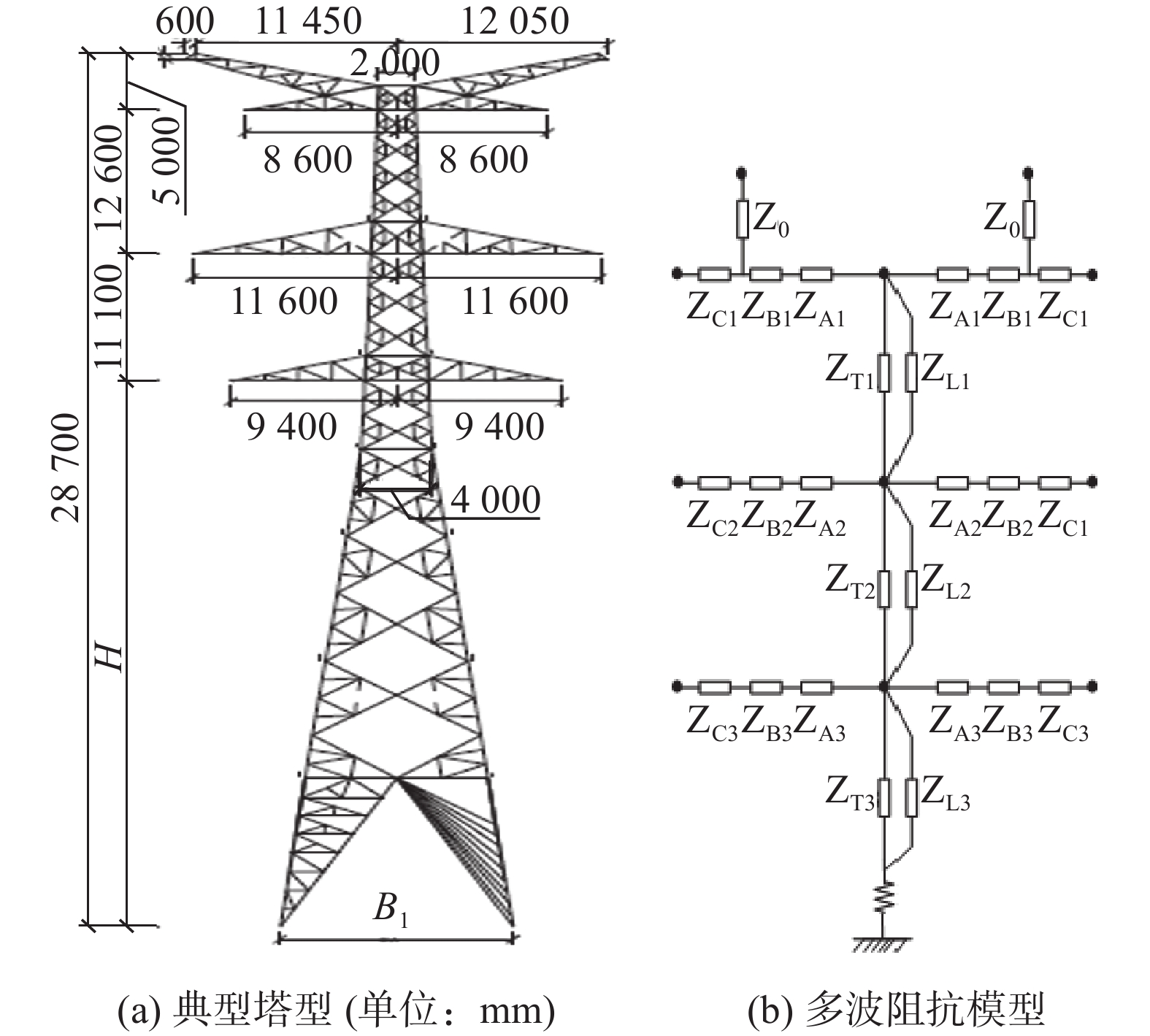

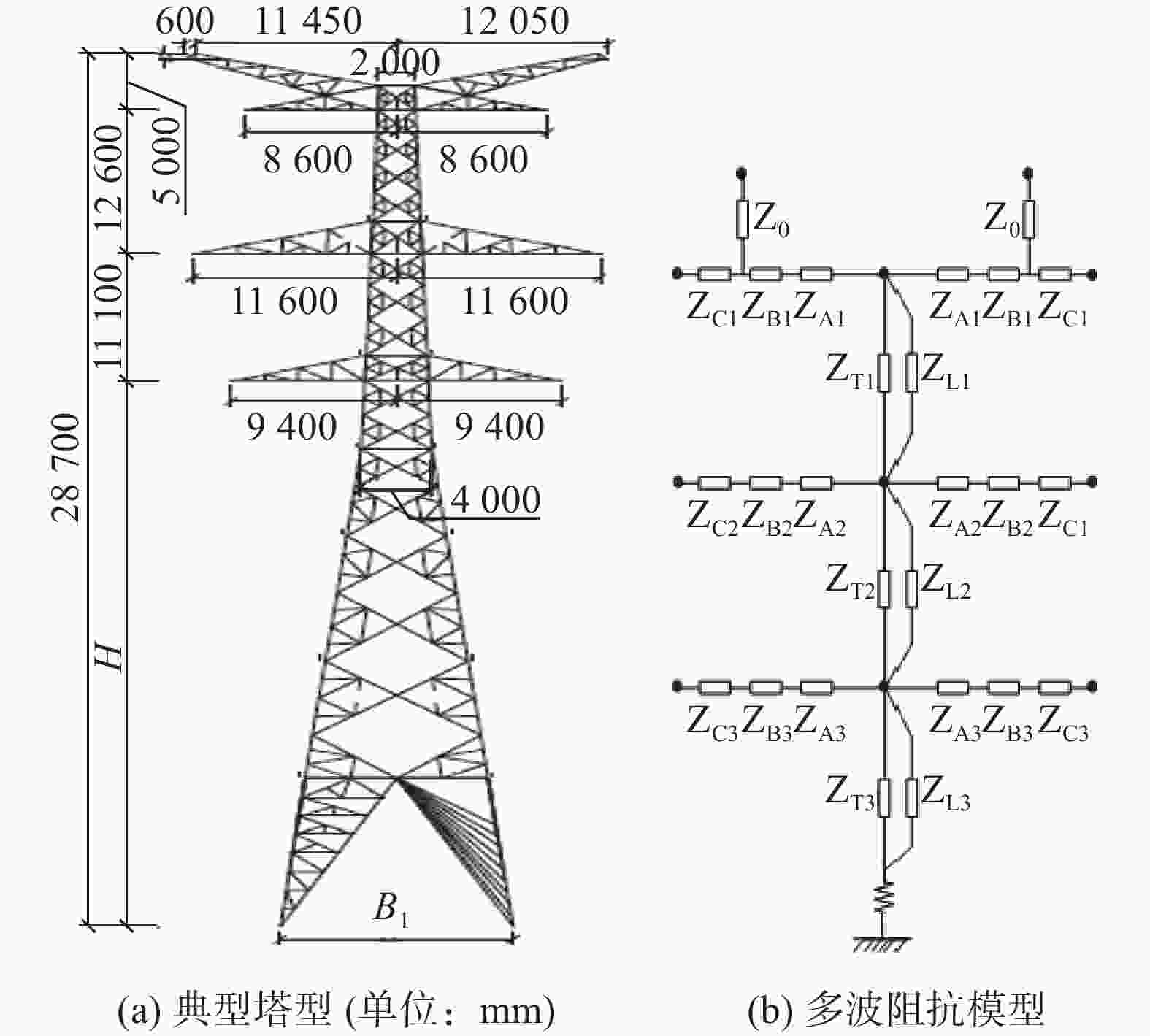
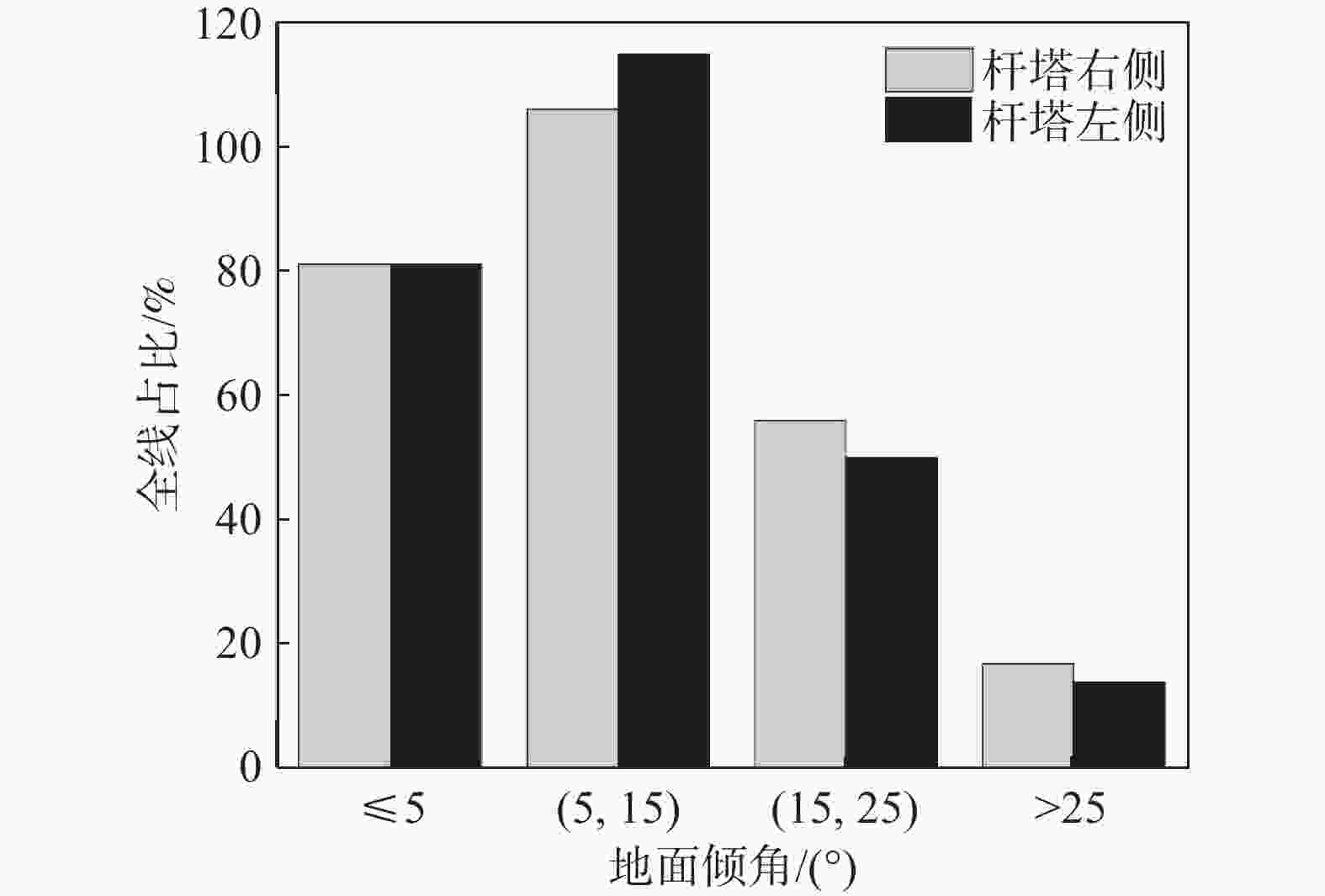
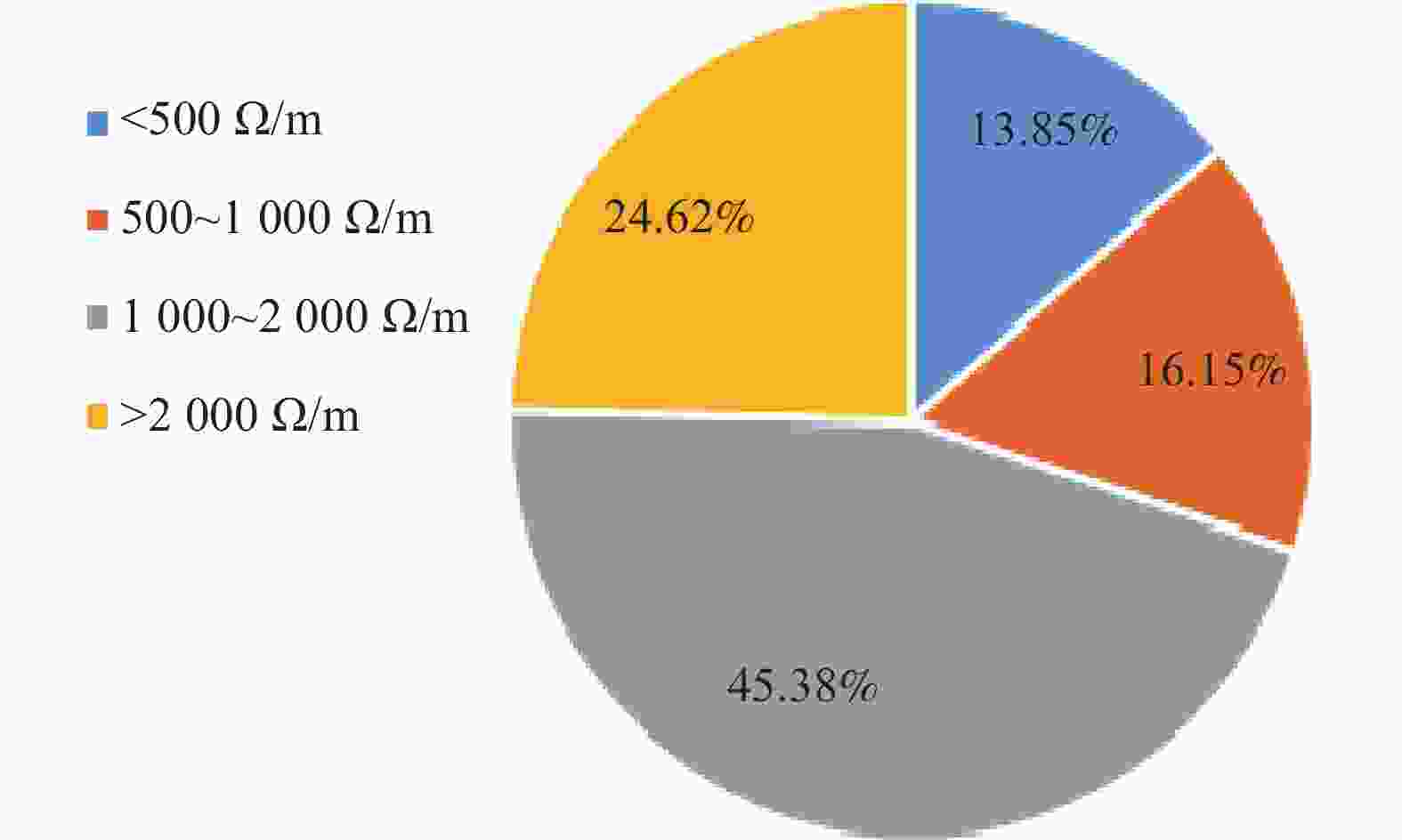
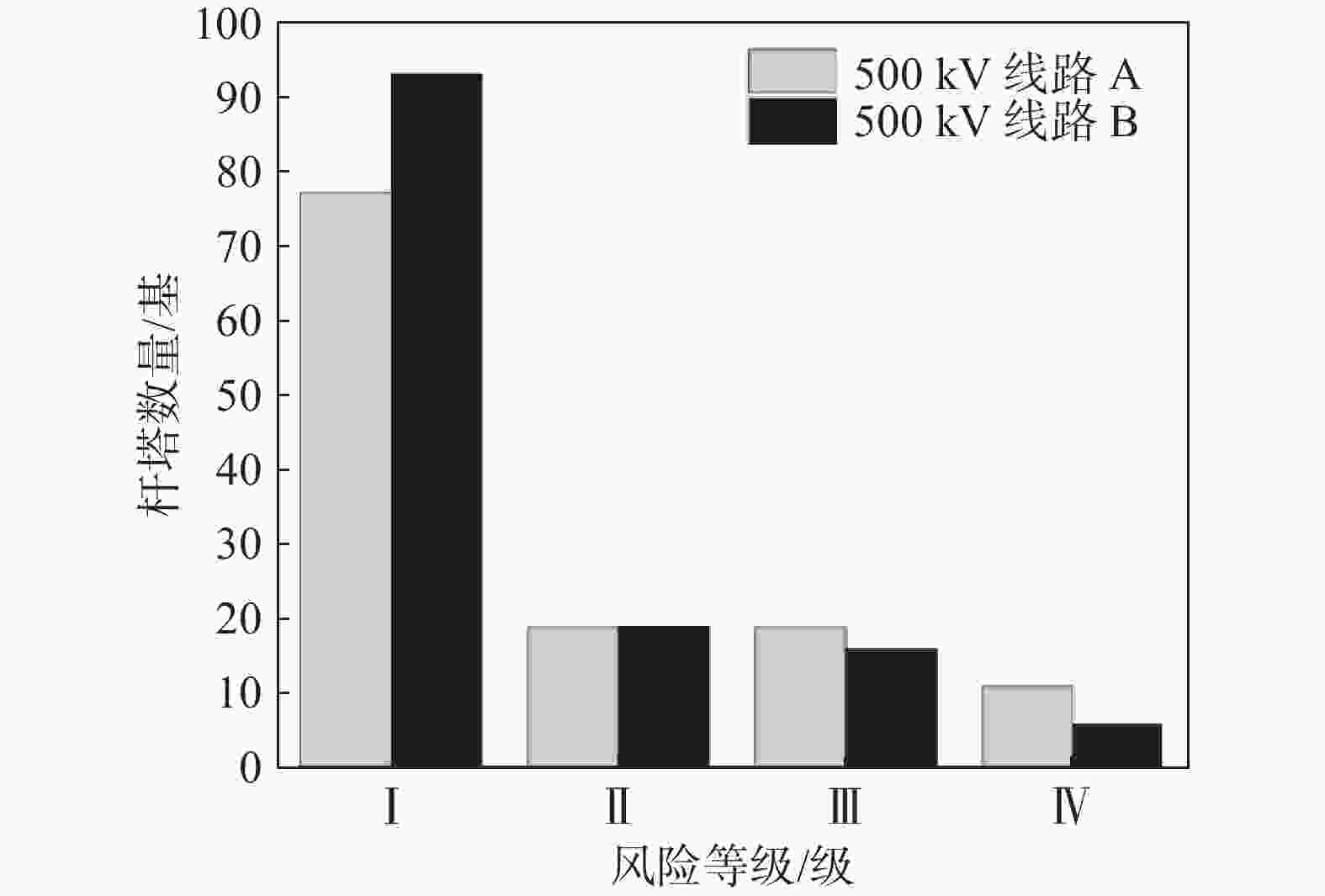
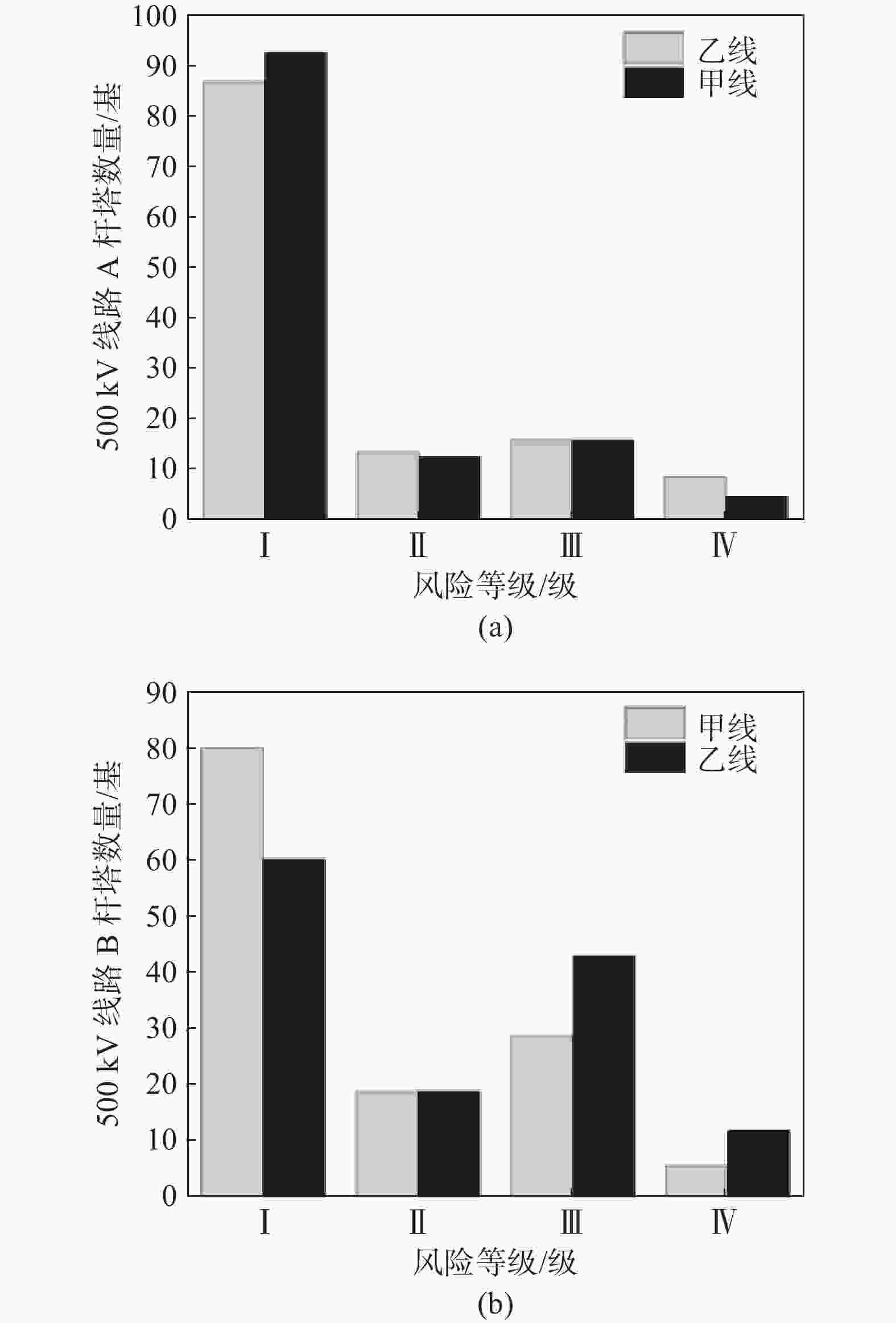
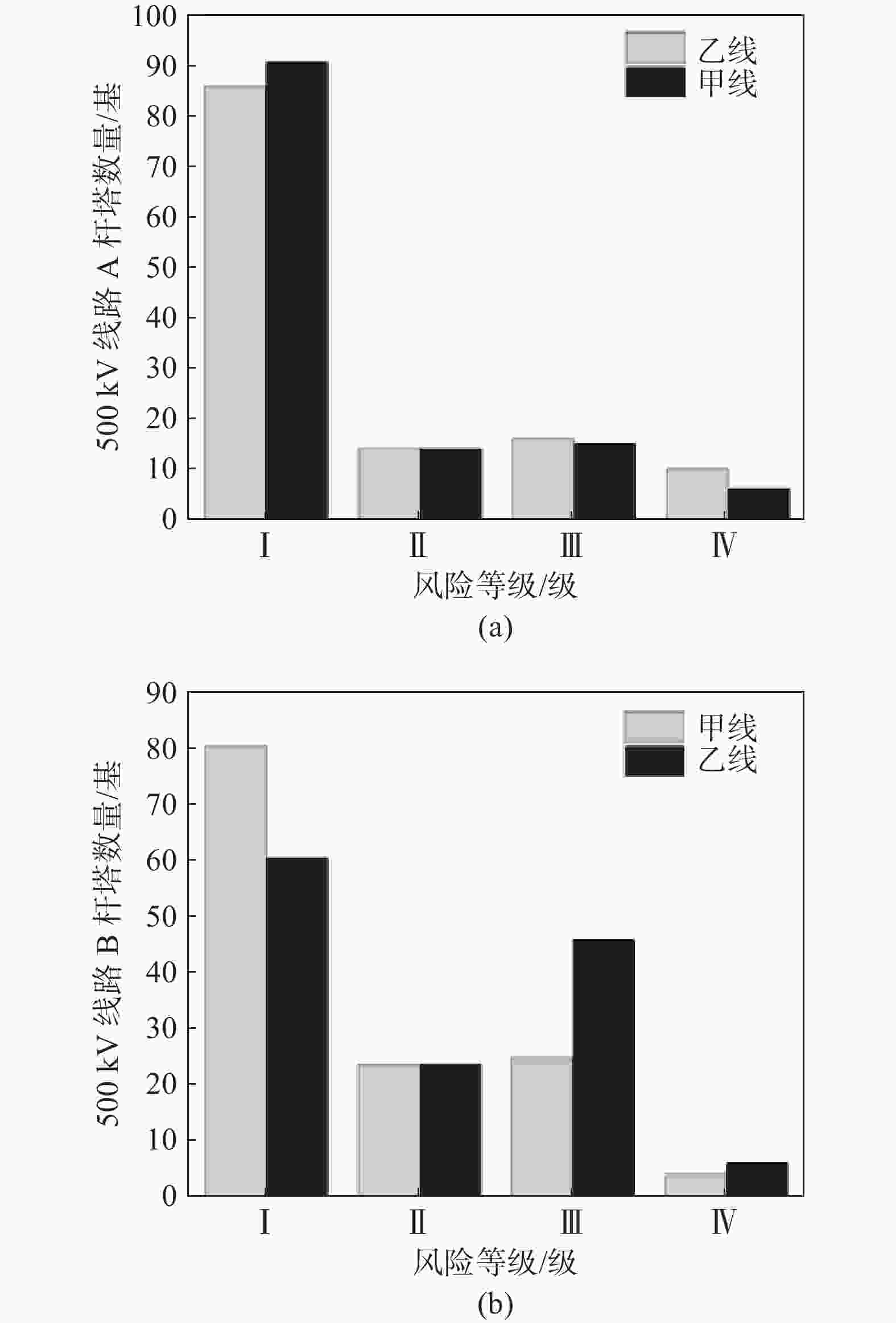
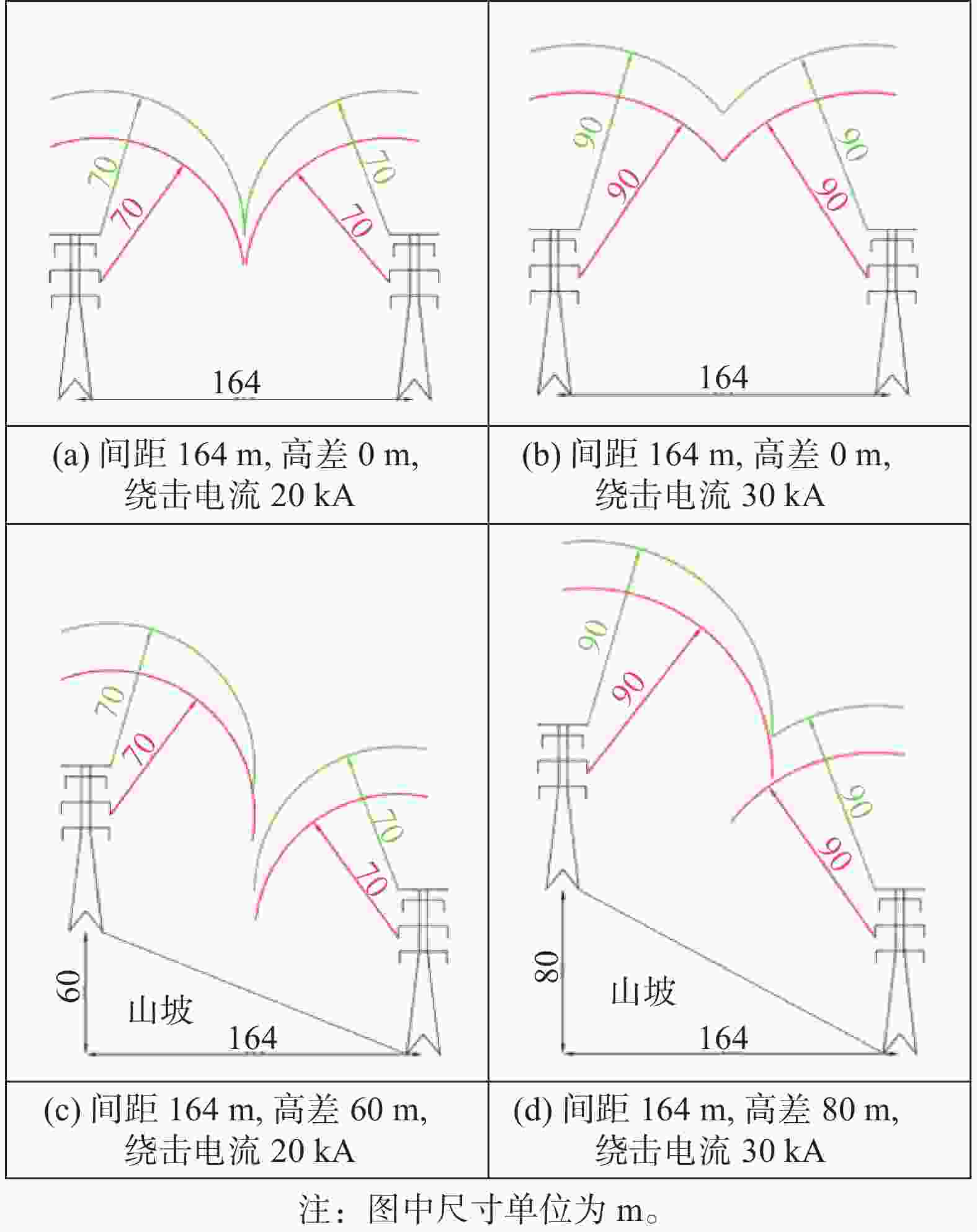

 DownLoad:
DownLoad:
